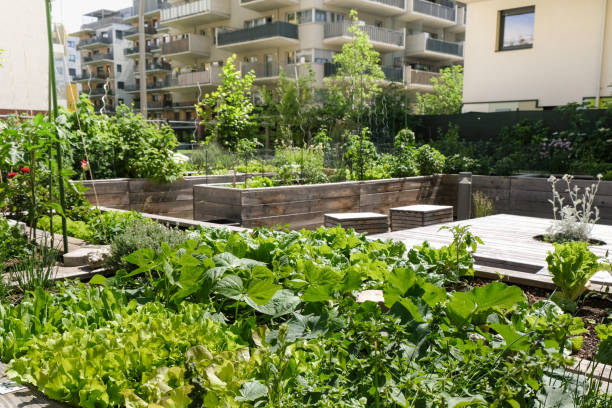Vertical gardening solutions for limited outdoor areas
Vertical gardening transforms small patios, balconies, and narrow yards into productive, attractive green spaces. By stacking plants, using walls, trellises, and containers, you can increase growing area, support pollinators, and manage microclimates while conserving water. This article explains practical designs, materials, irrigation and soil strategies to help you plan a resilient vertical garden suited to limited outdoor areas.

Vertical gardening solutions for limited outdoor areas
Vertical gardening offers a practical approach when horizontal space is limited, turning walls, fences, and narrow pathways into layered plant zones. Beyond maximizing planting area, vertical systems can improve air quality, support biodiversity, and create microclimates that extend the growing season. Thoughtful choices about materials, irrigation, soil amendments like compost and mulch, and attention to drought and rainwater management will determine long-term success. The remainder of this guide outlines scalable solutions that suit balconies, small yards, and urban terraces, with an emphasis on sustainability and permaculture principles.
How do vertical designs attract pollinators?
In limited outdoor areas, arranging plants vertically creates dense, flower-rich patches that draw pollinators into compact sites. Use native flowering vines, vertical herb walls, and clustered containers with staggered bloom times to provide nectar and pollen across seasons. Incorporate shallow water features or damp dishes for small pollinators, and avoid pesticide use to protect insects. Plant choices that support pollinators also boost biodiversity and can be integrated with covercrops or flowering companions to provide continuous habitat in tight spaces.
How can I manage drought and use rainwater effectively?
Drought-resistant vertical gardens rely on efficient irrigation and water capture. Select drought-tolerant species, use mulch to reduce evaporation, and orient plantings to reduce direct midday sun exposure when possible. Install simple drip irrigation or wicking systems for containers to deliver water where roots access it. Harvest rainwater with a small barrel and gravity-fed tubing to refill reservoirs or connect to drip lines. Layered containers and vertical planters can be designed to channel excess rain into bottom reservoirs to reduce waste.
What role do compost and mulch play in vertical systems?
Soil volume in vertical planters is limited, so enriching potting mixes with compost increases nutrient retention and water-holding capacity. Use a lightweight, well-draining mix amended with mature compost, and top with organic mulch to stabilize temperatures and reduce moisture loss. Periodic feeding with compost tea or slow-release organic fertilizers offsets nutrient depletion. For very shallow systems, grow shallow-rooted herbs or leafy greens and rotate crops using covercrops in deeper pockets to rebuild organic matter between seasons.
Which materials and irrigation options work best for vertical gardens?
Choose durable, lightweight materials like treated cedar, recycled plastic planters, metal frames with corrosion-resistant coatings, or fabric pockets for hanging systems. Ensure materials are safe for edibles if you plan to grow food. For irrigation, low-pressure drip lines, modular irrigation emitters, or self-watering planters with wicks perform well in vertical setups. Consider modular trays that can be removed for maintenance. Proper drainage design prevents waterlogging; include catch trays to protect surfaces and allow reuse of runoff for other containers.
How does microclimate and season extension affect plant choices?
Vertical structures alter microclimates by providing windbreaks and shade, which can create milder conditions for tender plants. Use south- or west-facing walls to capture heat in cooler climates, or add shade cloth for hot exposures. Season extension tactics—cloches, removable plastic panels, or thermal mass elements like stone or water containers—can lengthen productive periods. Select species with complementary heat and cold tolerance to stagger harvests and reduce risk from late frosts or heatwaves.
How do permaculture and biodiversity inform sustainable vertical gardening?
Applying permaculture principles encourages diverse plantings, stacked functions, and resource cycling in vertical gardens. Combine edible plants with pollinator flowers, nitrogen-fixing companions, and plants that improve airquality or provide pest-repellent traits. Integrate small-scale composting or worm bins nearby to close nutrient loops. Promoting biodiversity—through native species, layered habitats, and continuous bloom—strengthens resilience against pests, supports local ecosystems, and aligns with sustainability goals in urban and suburban settings.
Conclusion
Vertical gardening is a flexible strategy for making the most of limited outdoor areas while supporting pollinators, conserving water, and increasing biodiversity. By selecting appropriate materials, using efficient irrigation and compost-enriched soils, and considering microclimate and season extension techniques, you can create productive, sustainable vertical systems that fit balconies, terraces, and narrow yards worldwide. Thoughtful design rooted in permaculture and local plant selection will improve long-term success and ecological benefits.




